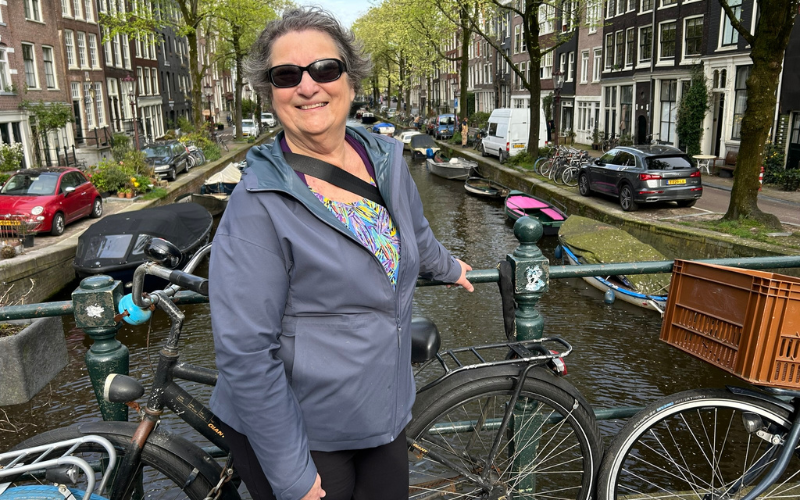Two Terrific Small Museums In Amsterdam You Should Visit
This post may contain affiliate links to products or services I'm happy to recommend. If you click on an affiliate link and then make a purchase, Artsy Traveler may earn a small commission at no cost to you. Thank you!
I love Amsterdam, which is why on almost every trip to Europe I make it my first stop. Since 1970 on my epic first trip to Europe with my mom, I’ve visited Amsterdam fifteen times. You’d think I’d have run out of places to see by now, but I haven’t. On my most recent visit to Amsterdam in April 2024, I discovered two new-to-me museums that I highly recommend.
First is the National Maritime Museum (#1 on the map below) and second is the Rembrandt House Museum (Rembrandt Huis – #2). Both deliver an excellent bang for your euro. The map below also shows the location of my recommended hotel (#3) and for context, Amsterdam’s two heavyweight museums: the Rijksmuseum (#4) and the Van Gogh Museum (#5).
National Maritime Museum
Despite all my visits to the city, I’d never heard about Amsterdam’s excellent Maritime Museum. On my latest trip, the taxi drove us right past the massive replica of an 18th century Dutch three-master sailing ship (the Amsterdam) moored in the harbor. I asked him what it was and he told us it was part of the National Maritime Museum. Intrigued, I looked it up when we got to the hotel, which turned out to be only a six-minute walk away.
Arriving at the National Maritime Museum
The National Maritime Museum is housed in a stately three-storey building on the edge of Amsterdam’s massive harbor and adjacent to the Amsterdam ship moored in the harbor. After entering at the south side of the building, we walked into a spacious covered atrium with entrances leading to the north, west and east.
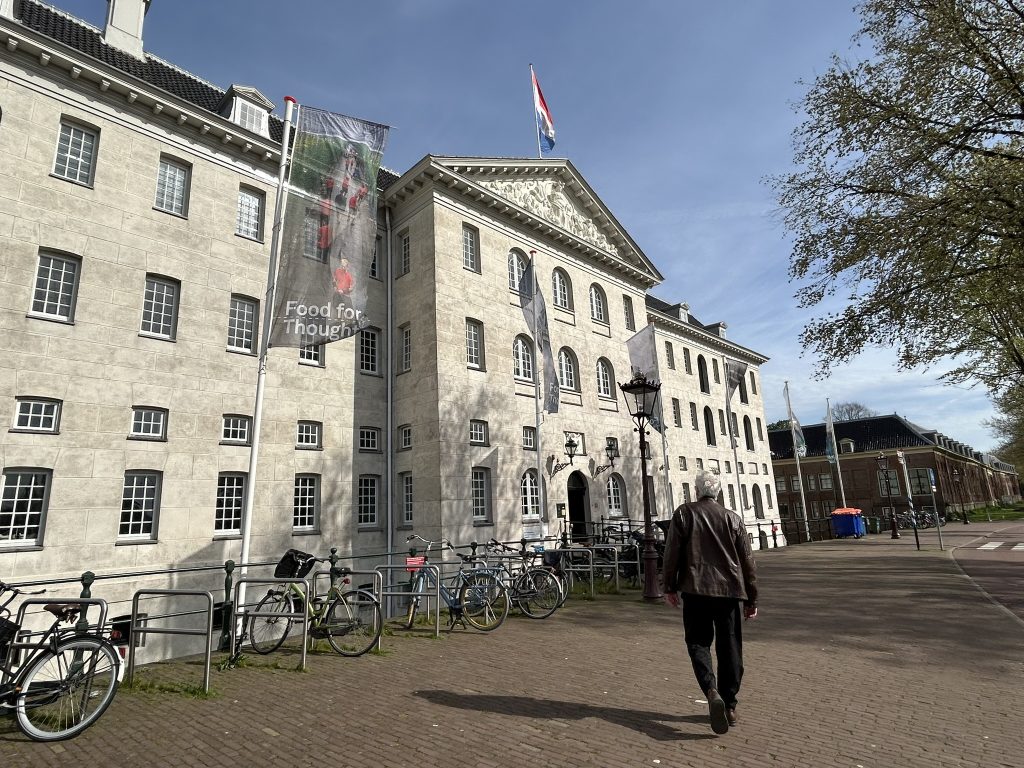
Touring The Amsterdam
We headed first for the north door that led straight out to a wharf and the docked replica of the Amsterdam. What a sight! The huge hull rose several storeys above our heads, above which soared three masts.
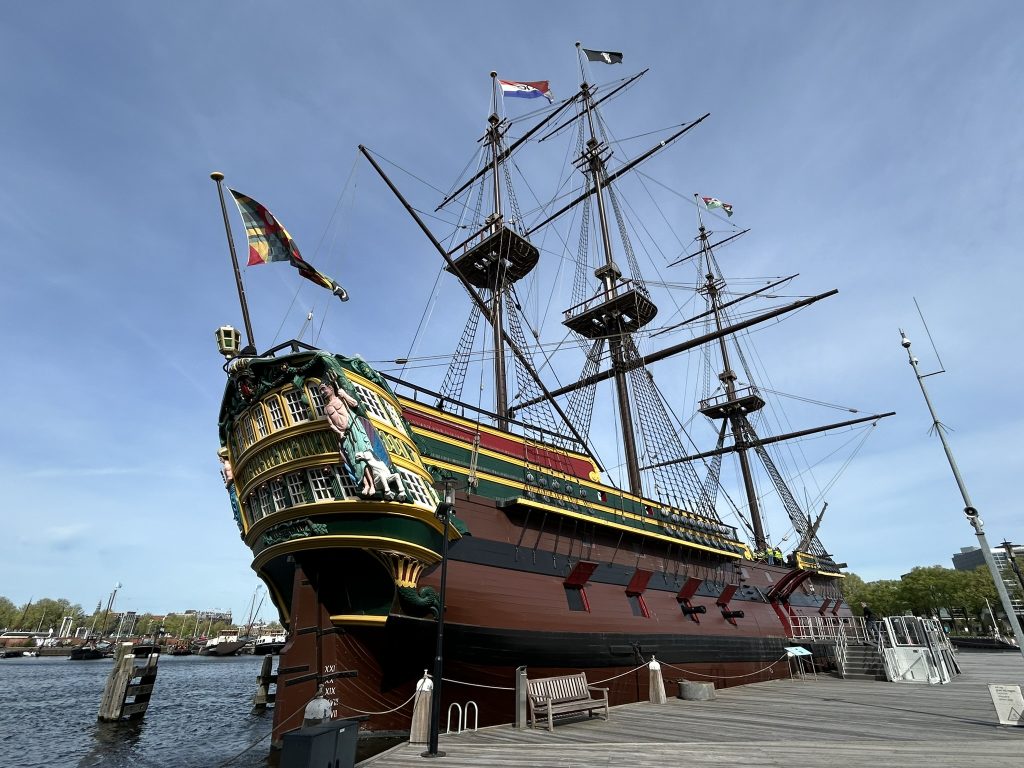
We boarded the ship and were immediately engulfed by a posse of schoolchildren all wearing yellow safety vests and swarming through the sailors’ quarters. Apart from the kids, the quarters looked spacious until I realized the space would house a crew of 191 sweaty sailors. The smells and swells on a rough day at sea would not have been pretty.
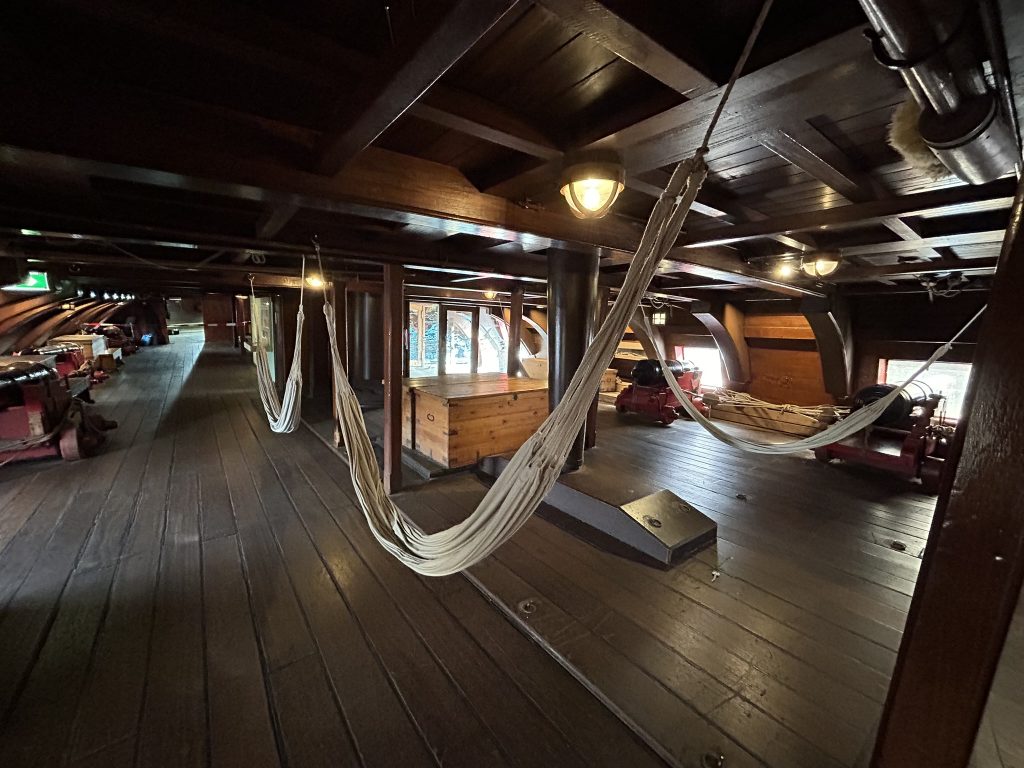
Information about the Amsterdam
Throughout the ship, descriptions in both English and Dutch provided fascinating glimpses into the history of the original Amsterdam and Dutch trade back in the 17th and 18th centuries. I learned that on one voyage, the Amsterdam carried one captain, 191 sailors, 128 marines, 11 artisans, and 3 women passengers for a total of 334 people. That’s a lot of bodies to squeeze onto a ship that, while large, wasn’t that large. I found it a bit crowded with a school group of maybe 30 kids!
Eating on the Amsterdam
In the galley at the front of the ship, the cook would prepare meals for everyone on board, who would then take turns eating in groups of seven. The captain and passengers got the best and freshest food, leaving the crew to half starve and fall prey to diseases such as typhus, dysentery, and scurvy. It must have been pretty grim, particularly since long voyages to destinations in the East Indies took many, many months.
Women Dressed as Men
I was particularly taken by a description of women dressed as men who sailed on the Dutch ships. Some were forced by circumstances to earn money; some were likely trying to escape an unhappy marriage; some maybe just wanted adventure. Unfortunately, any woman who was trying to pass herself off as a man on a ship was severely punished.
In 1770, a woman called Margereta Reymers dressed as a man and joined the crew of the East Indiaman Schoonzicht under the name Hans Hendrik Reymers on a ship sailing to Asia. Margereta was discovered two months into the voyage and put ashore at Cape Town where a man who had promised to marry her left her pregnant.
Eventually, Margereta managed to find a place on a ship returning to the Netherlands. Her daughter was born at sea. No one knows what happened to Margereta and her daughter afterwards. Hmmm – therein lies an interesting idea for a novel!
The Maritime Museum Exhibits
The museum itself is quite vast and beautifully curated. If you are into ships, navigation, and sailing, you could spend many happy hours there. I particularly enjoyed the displays of figureheads and model ships.
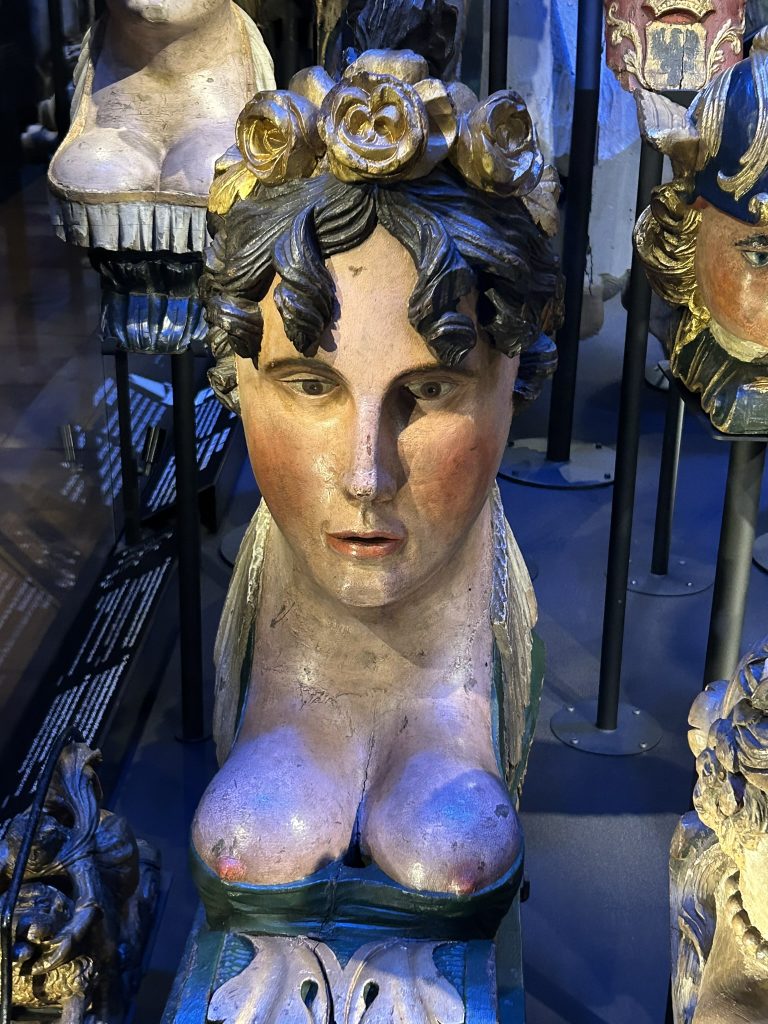

For more information about the National Maritime Museum, check out their informative website: https://www.hetscheepvaartmuseum.com/
After touring the National Maritime Museum, we enjoyed lunch in a typical Dutch pub, then headed to the Rembrandt House Museum, which was about a ten minute walk from our hotel.
The Rembrandt House Museum
Unlike the National Maritime Museum, I had heard about the Rembrandt House Museum, but had never managed to visit it. I thought it would be a rather dusty old place with little to recommend it beyond the fact that Rembrandt once lived there.
I discovered that I was wrong and that the Rembrandt House Museum is well worth an hour of any artsy traveler’s time.
Renovated Museum
The museum has been recently renovated to include an adjacent building containing the entrance area, a gift shop (of course), and two floors of exhibition space.
We entered the airy modern foyer, purchased our tickets and picked up our audio guides. We don’t usually go for audio guides, but the man at the desk told us they were essential to our enjoyment of the museum and so we dutifully donned the earphones and headed for door leading into the house that Rembrandt called home for 19 years.
Touring Rembrandt House
For the next hour or so, we drifted from room to room and up several sets of winding staircases to explore the nooks and crannies of what was—and still is—a large and comfortable home. Rembrandt was flying high when he and his wife purchased the house. He was receiving many commissions in addition to earning a sizable chunk of his income from teaching wannabe Rembrandts.
But regrettably, Rembrandt was not the best of businessmen. After nineteen years of enjoying the good life, Rembrandt’s many creditors forced him to sell just about everything not nailed down and move across town.
Rembrandt’s Misfortunes are History’s Gains
I learned that it was thanks to Rembrandt’s financial misfortunes that his house has been so immaculately recreated. When Rembrandt was forced to liquidate all his assets, he left behind an extremely detailed inventory of the house contents. Historians were able to use this inventory to faithfully recreate the rooms in his house so that today we can wander through them secure in the knowledge that they looked more or less the same as they did in Rembrandt’s day—except with electric light and tourists listening to audio guides.
The comprehensive audio guide provided us with a wealth of information about each of the rooms we entered—from grand salon to the room of curiosities to Rembrandt’s gorgeously bright and airy painting studio. In each room, audio commentary described the room and its uses, and provided information about Rembrandt’s life and work.
Rembrandt House Highlights
Box Beds
One of several box beds in the house was situated in the main salon, and like every box bed in the house (there were several) was much shorter than would seem reasonable to accommodate an average-sized human. I learned that back in Rembrandt’s time, people slept sitting up and so had no need of a bed that extended their full height. Apparently, the prevailing medical wisdom of the day dictated that sleeping completely prone was very bad for the health. Peering into the box beds, I shuddered at the thought of actually sleeping in one. If you are at all prone to claustrophobia, you wouldn’t last ten minutes.
The box bed shown below was in the main salon and would be for visitors.
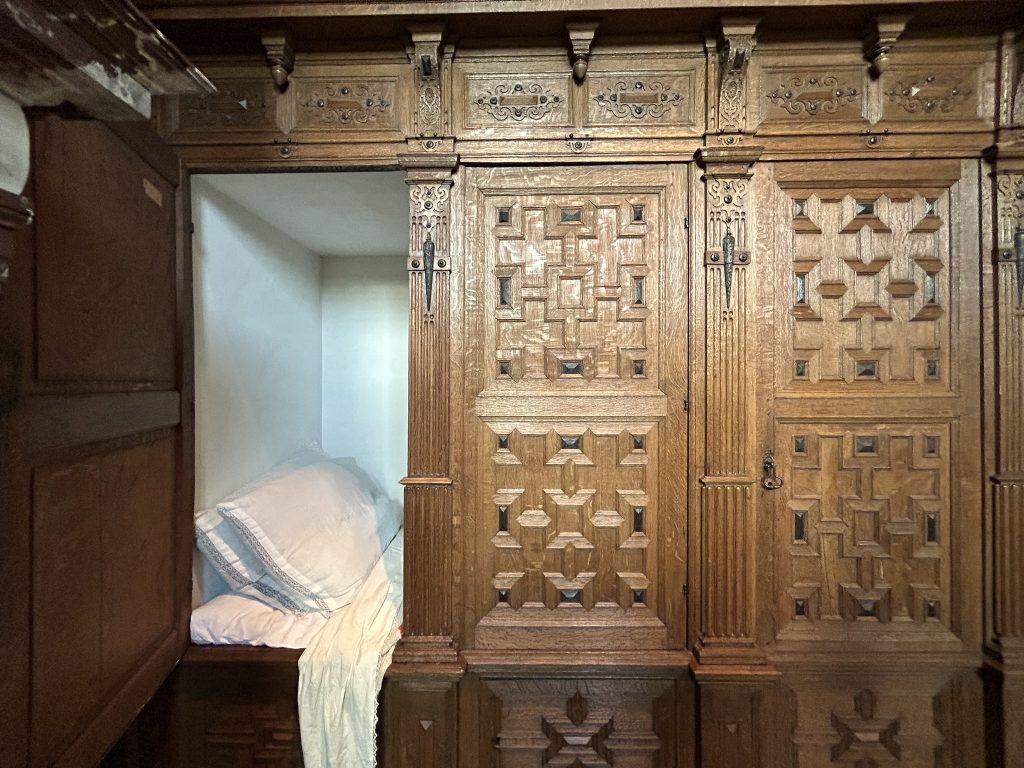
Etching Studio
Rembrandt was known for his etchings, many of which he made in the etching studio. Nowadays, a rubber-gloved attendant demonstrates the art of etching. Unfortunately, we missed her demonstration but it was likely very similar to the one we saw at the house of Albrecht Dürer in Nuremberg. In fact, the setup of the Rembrandt House Museum reminded me of the Dürer museum. You can read about our visit there in my page about Artsy Sightseeing in Germany.
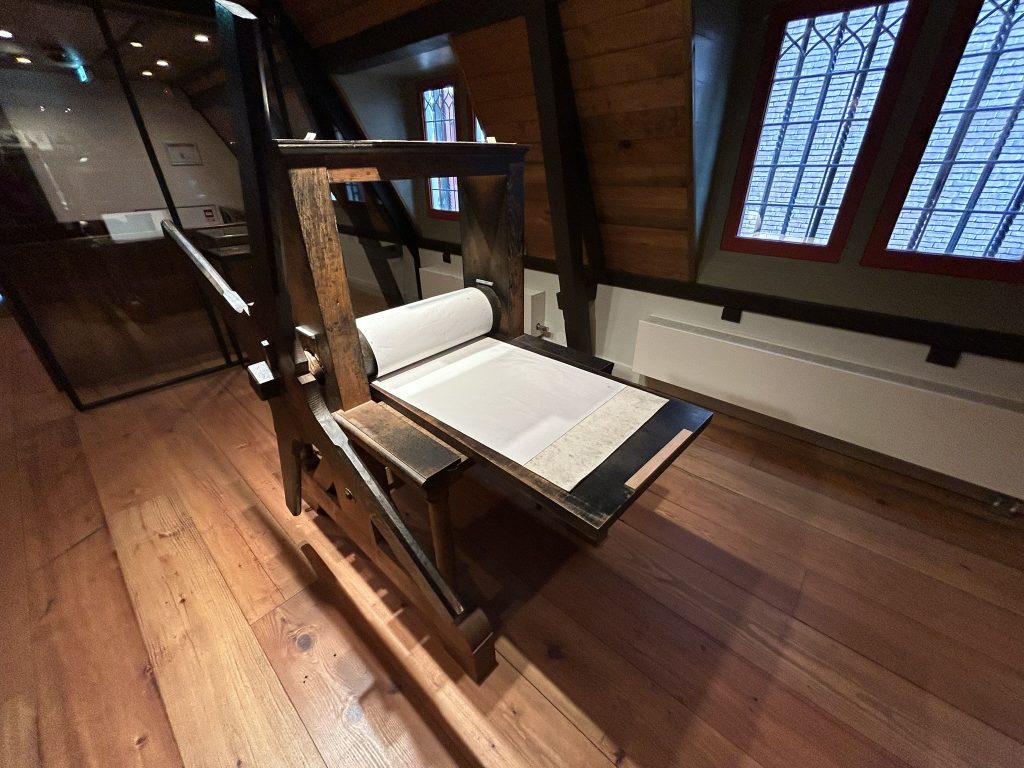
Painting Studio
Stepping into Rembrandt’s large painting studio feels quite magical. Although now filled with visitors all listening intently to their audio guides, it’s salutary to remember that you are actually treading the same floor boards and looking out the same windows as Rembrandt did four hundred years previously.
The room faces north, an aspect favored by painters because the light varies the least throughout the day. The studio is at the top of the house and so would have been as bright and airy as any room in a 17th- century house could be.
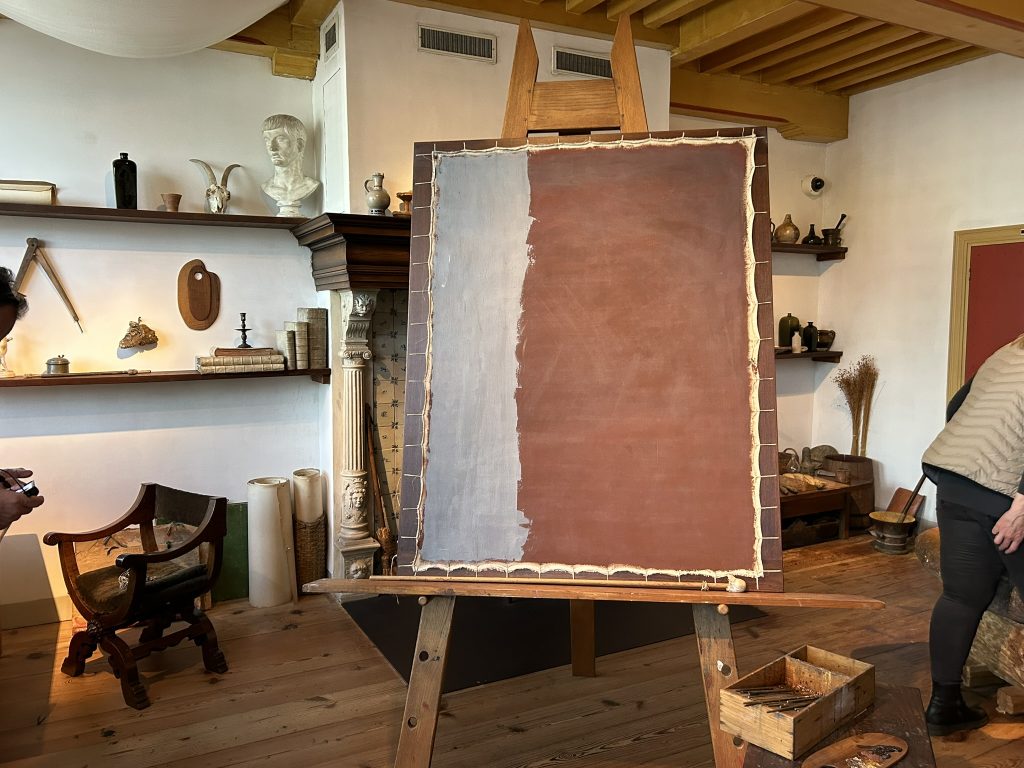
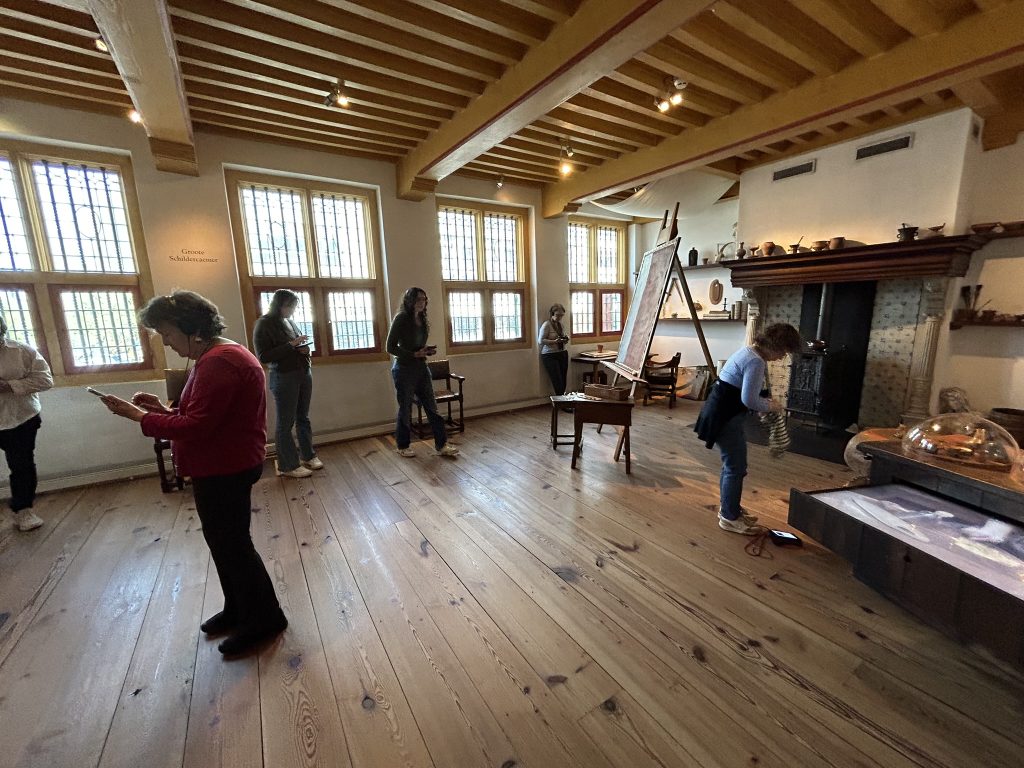
The studio includes a large video screen that shows a demonstration of how Rembrandt and his assistants made pigments. I’m familiar with the process of grinding and mixing the pigments from my research for The Towers of Tuscany. But whereas my characters in 14th-century Italy mixed their pigments with egg yolks, Rembrandt and his contemporaries mixed pigments with linseed oil.
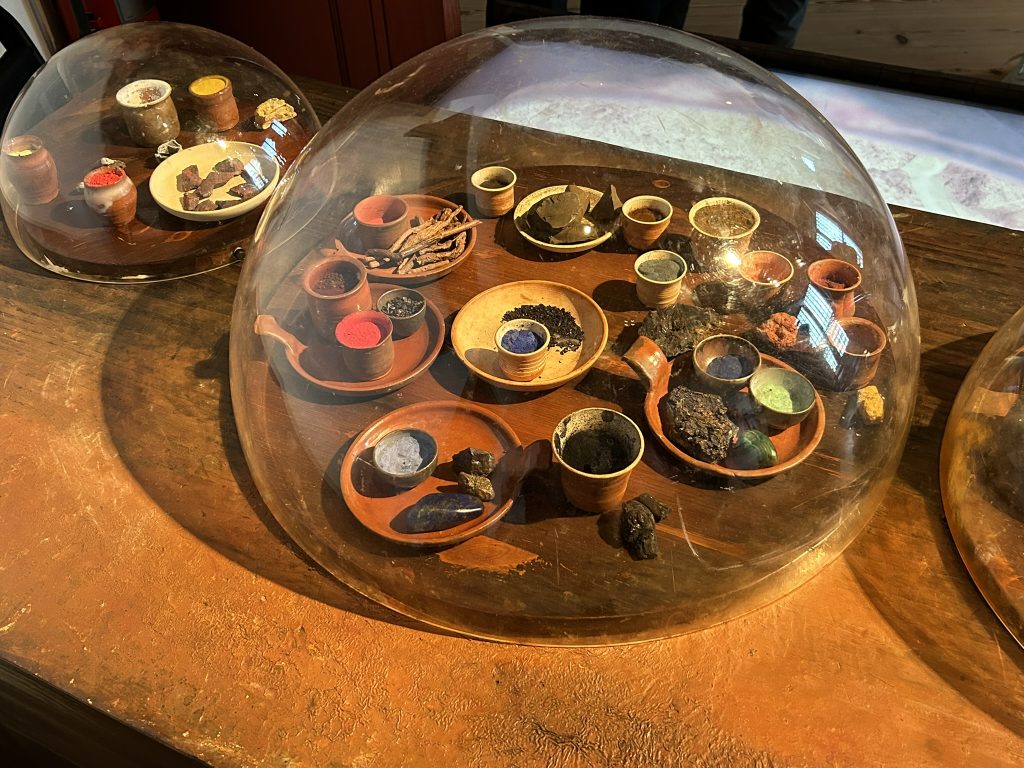
Small Painting Studio
I was quite taken with the second painting studio which was partitioned into four sections to accommodate four students.The whole setup looked so modern. Apparently, Rembrandt made 30% of his annual income from students, but even that income wasn’t enough to keep him afloat. I wonder what became of the students after Rembrandt had to liquidate!
But check out these studios. Many artists would feel quite at home in one today!
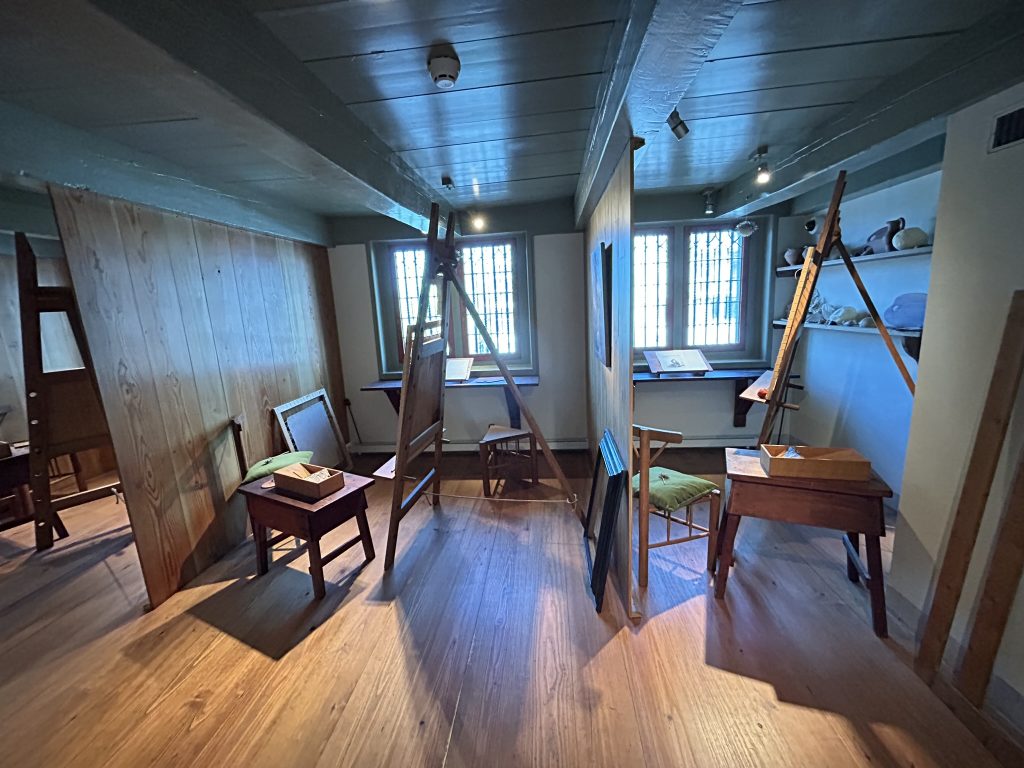
The Room of Curiosities
Like many people of his time, particularly artists, Rembrandt was an avid collector. His many collections fill the room of curiosities–from parrot feathers and stuffed caimans and armadillos, to tortoise shells, butterflies, rocks, and a hundred other exotic bits and pieces he accumulated over the years. Amsterdam, of course, was a port, and so Rembrandt was able to acquire objects from around the globe that had been brought to Amsterdam by the sailors.
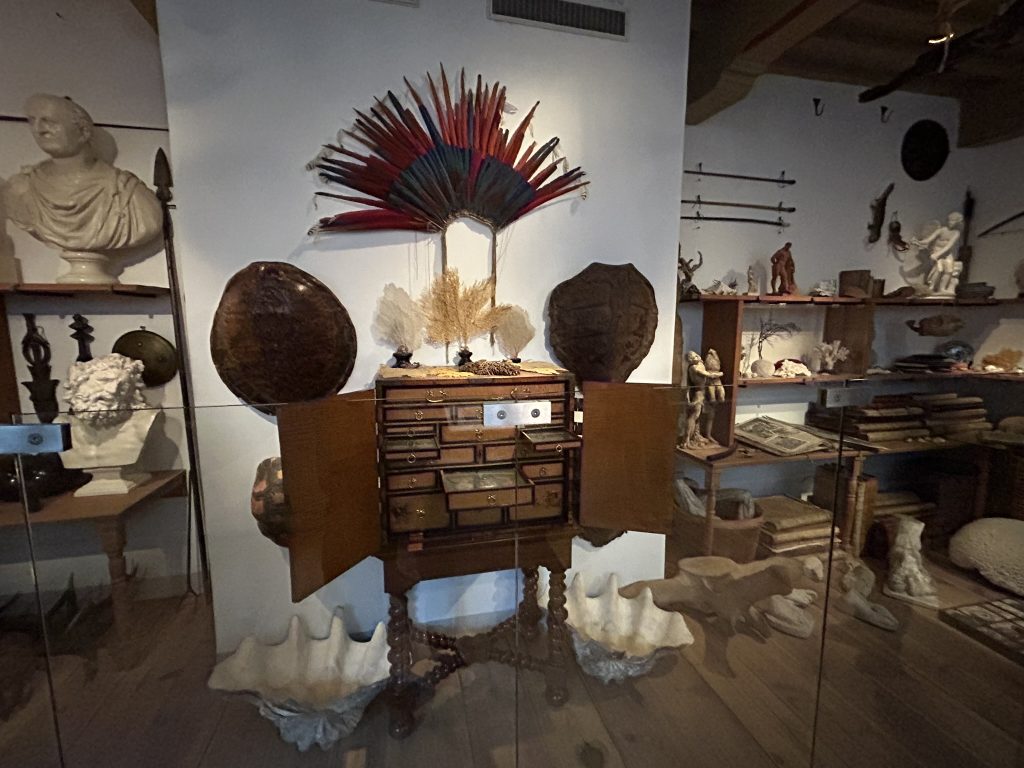
Exhibition Center
After touring Rembrandt’s house, we funneled back into the exhibition center. There wasn’t much on when we were there, but I did appreciate the projection of a montage of Rembrandt’s greatest hits.
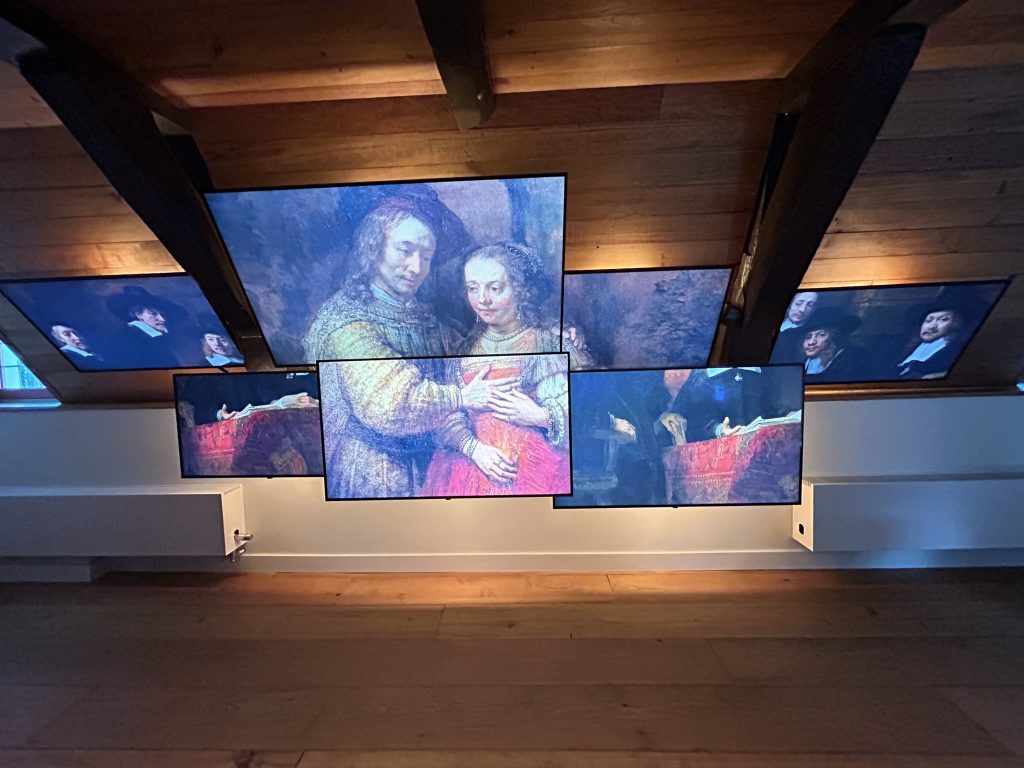
Visiting Rembrandt’s House
For more information and to purchase tickets, check out the Rembrandt House website: https://www.rembrandthuis.nl/en/
You can also purchase your tickets in advance from Get Your Guide. As I’ve mentioned many times on Artsy Traveler, I’m a big fan of Get Your Guide. Click the image below to go to their website.
Wandering Around Amsterdam
On my stopover in Amsterdam in 2024, I stayed only two nights, but still managed to log several kilometers of wandering. Amsterdam is a fantastic city for walking, so long as you keep a very sharp eye out for cyclists. They go very, very fast! I wonder how many tourists who stepped off a curb without looking ended up in Emergency.
In the evening of our only full day in Amsterdam, we met Gregg’s artist friend Rik Lina in his home and went out for a wonderful Caribbean dinner. Here Rik is with Gregg in front of one of his paintings. He and Gregg have been collaborating for years. Notice the collection of masks. Like Rembrandt, Rik is an avid collector.
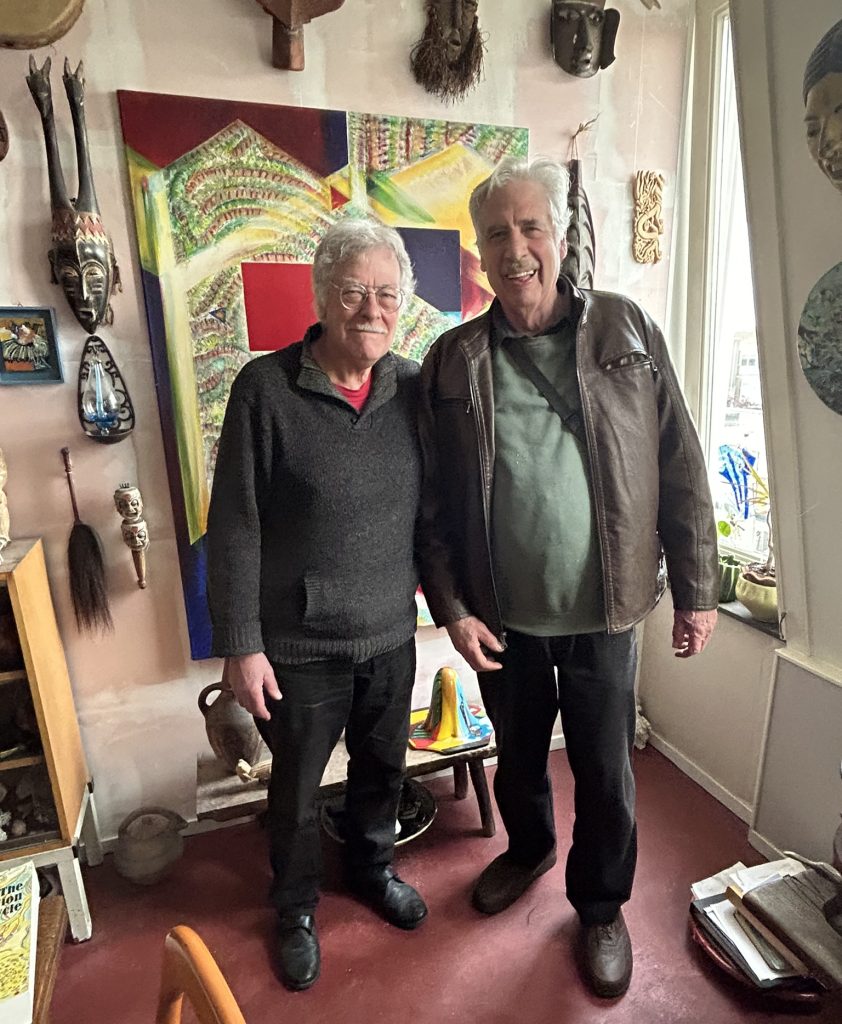
Amsterdam at Night
After dinner, we strolled through Amsterdam in the moonlight, crossing many canals and passing an endless number of intriguing storefronts. Amsterdam has an admirably eclectic variety of stores carrying everything from Old Master knock-offs to rubber duckies to high fashion to painted cows. I adore window shopping in Amsterdam.
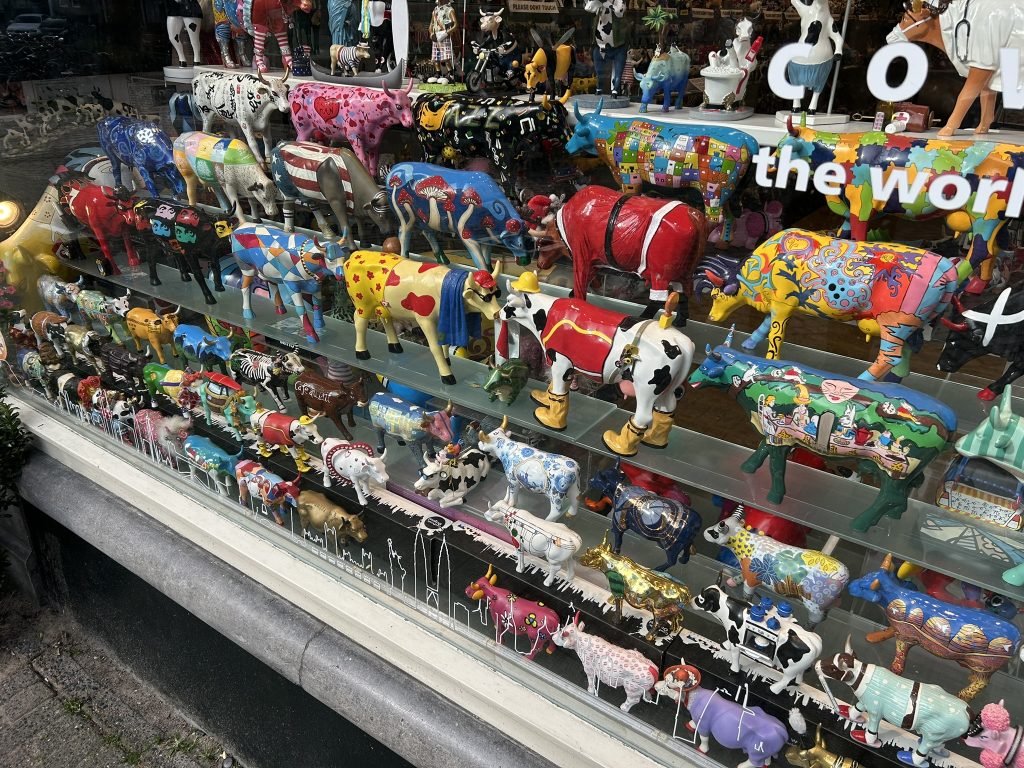
Amsterdam at night truly is magical! The side streets are quiet, the canals serene in the moonlight, the bike traffic considerably calmed. You can wander for hours, imagining yourself into a cityscape that hasn’t changed appreciably for four hundred odd years.
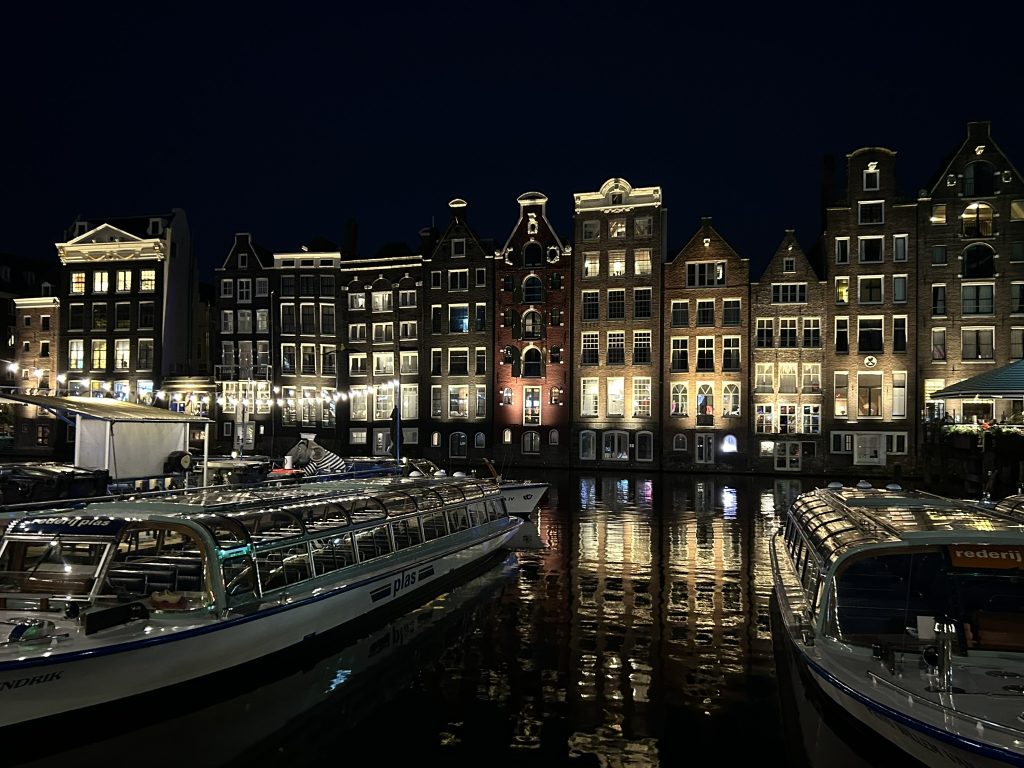
Other Tours in Amsterdam
There’s so much to see in Amsterdam for the artsy traveler! I highly recommend booking one of the Get Your Guide tours, if only to skip the line at the most popular museums. I’ve consistently found Get Your Guide tours to be good value, and have taken them in Rome, Venice, Paris, Madrid, and Sirmione. Here are links to Get Your Guide tours in Amsterdam.
Full disclosure: If you click on a Get Your Guide link and purchase a tour (any tour), I receive a small commission. Thank you.
Staying in Amsterdam
Over the years, I’ve stayed in many different places in Amsterdam–from Airbnbs to hotels on the outskirts. Our stay in 2024 was one of the best–and also the most reasonably priced considering the location and amenities.
I’m not usually a big fan of chain hotels, but to my surprise the Holiday Inn Express – City Hall in Amsterdam, steps from the harbor and within walking distance of old Amsterdam, was a perfect choice. The view of the canal from our window was endlessly fascinating depending on the time of day and the shifting April weather, the room was comfortable, and the staff friendly and helpful.
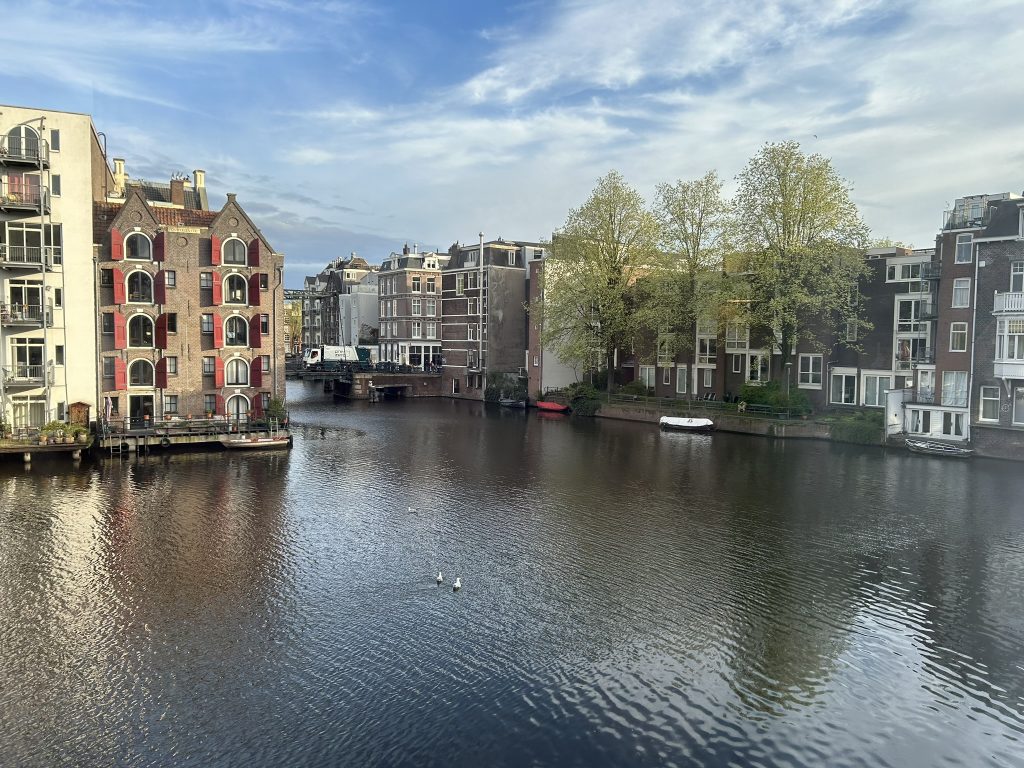
I also appreciated the large urn full of citrus fruits and water in the lobby. Every time I came into the hotel, I helped myself to a refreshing glass of citrus water.
Here are other options for staying in Amsterdam. I recommend you resist the temptation to opt for the cheaper places outside the city center. Amsterdam is worth the splurge. Book a place as close to the ring of canals as you can and enjoy many happy hours of wandering–particularly after dark.
Conclusion
Have you visited Amsterdam? What are some of your best picks? Share your experiences in the comments below.
For more about Amsterdam, check out these posts:
